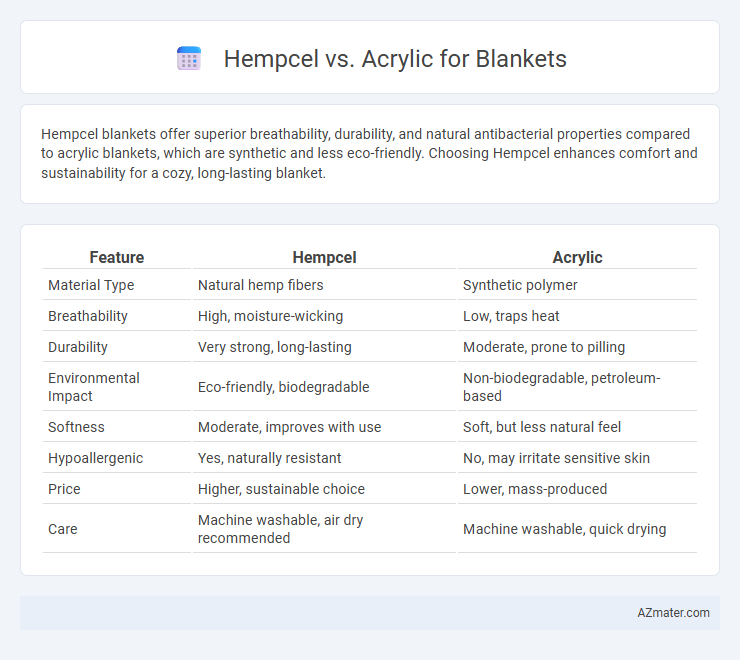Hempcel blankets offer superior breathability, durability, and natural antibacterial properties compared to acrylic blankets, which are synthetic and less eco-friendly. Choosing Hempcel enhances comfort and sustainability for a cozy, long-lasting blanket.
Table of Comparison
| Feature | Hempcel | Acrylic |
|---|---|---|
| Material Type | Natural hemp fibers | Synthetic polymer |
| Breathability | High, moisture-wicking | Low, traps heat |
| Durability | Very strong, long-lasting | Moderate, prone to pilling |
| Environmental Impact | Eco-friendly, biodegradable | Non-biodegradable, petroleum-based |
| Softness | Moderate, improves with use | Soft, but less natural feel |
| Hypoallergenic | Yes, naturally resistant | No, may irritate sensitive skin |
| Price | Higher, sustainable choice | Lower, mass-produced |
| Care | Machine washable, air dry recommended | Machine washable, quick drying |
Introduction to Hempcel and Acrylic Fabrics
Hempcel fabric, derived from the cellulose of hemp plants, offers exceptional durability, breathability, and natural antibacterial properties, making it an eco-friendly choice for blankets. Acrylic fabric, a synthetic material made from polymer fibers, is prized for its softness, warmth, and resistance to moths and wrinkles but lacks the biodegradability and moisture-wicking benefits of hempcel. When comparing Hempcel vs Acrylic for blankets, hempcel's sustainability and hypoallergenic qualities stand out, while acrylic provides affordable insulation and easy-care maintenance.
Material Composition: Hempcel vs Acrylic
Hempcel blankets are made from a natural hemp fiber blend that provides durability, breathability, and eco-friendly benefits, while acrylic blankets consist of synthetic polymers designed for softness and affordability. Hempcel's material composition offers moisture-wicking and antimicrobial properties, enhancing comfort and hygiene during use. In contrast, acrylic fibers may retain heat and lack the natural biodegradability found in hemp-based textiles.
Sustainability and Environmental Impact
Hempcel blankets offer superior sustainability compared to acrylic counterparts, being made from natural hemp fibers that require minimal water and no pesticides, significantly reducing environmental footprint. Hempcel is biodegradable and compostable, contrasting with acrylic, a synthetic material derived from petroleum, which contributes to microplastic pollution and takes centuries to decompose. The renewable nature of hemp cultivation alongside its carbon sequestration capabilities positions Hempcel as an eco-friendly choice in sustainable textile production for blankets.
Softness and Comfort Comparison
Hempcel blankets offer a natural softness that improves with each wash, providing breathable comfort and moisture-wicking properties ideal for sensitive skin. Acrylic blankets, while initially plush and lightweight, may lack breathability and can trap heat, potentially causing discomfort during extended use. Choosing hempcel ensures a balance of durability and soft comfort, outperforming acrylic in long-term coziness and temperature regulation.
Warmth and Insulation Abilities
Hempcel blankets offer superior breathability and moisture-wicking properties, ensuring consistent warmth without overheating, making them ideal for regulating body temperature. Acrylic blankets provide effective insulation and retain heat well, offering a plush, cozy feel even in colder climates. Hempcel fibers allow better airflow and natural temperature regulation, whereas acrylic delivers reliable warmth with a synthetic fiber's durability.
Durability and Longevity
Hempcel blankets offer superior durability compared to acrylic blankets due to their natural fiber strength and resistance to wear and tear, making them ideal for long-term use. Hemp fibers possess excellent tensile strength, contributing to enhanced longevity even after multiple washes, while acrylic materials tend to degrade faster under frequent use and exposure to heat. Choosing a hempcel blanket ensures a more sustainable and resilient product that maintains its quality over time.
Breathability and Moisture Management
Hempcel blankets offer superior breathability due to their natural, porous fibers that allow better air circulation and temperature regulation. Acrylic blankets tend to trap heat and moisture, leading to less effective moisture management and reduced comfort during extended use. The moisture-wicking properties of Hempcel fibers promote a dry, cool sleeping environment, making them ideal for users seeking enhanced breathability and moisture control.
Allergenicity and Skin Sensitivity
Hempcel blankets offer superior hypoallergenic properties compared to acrylic, making them ideal for individuals with sensitive skin or allergies. Hemp fibers are naturally resistant to dust mites, mold, and mildew, reducing the risk of skin irritation and allergic reactions. In contrast, acrylic blankets can sometimes cause discomfort or exacerbate sensitivities due to synthetic fiber components and potential chemical residues.
Care, Maintenance, and Cleaning
Hempcel blankets require gentle care with cold water washes and mild detergents to preserve fiber integrity, avoiding bleach and high heat drying to prevent shrinkage or damage. Acrylic blankets offer easy maintenance with machine-washable durability and quick drying times, resisting wrinkles and shrinking but may generate static and attract lint. Both materials benefit from air drying and low heat settings to extend blanket lifespan and maintain softness.
Cost Analysis and Value for Money
Hempcel blankets offer long-term cost savings due to their durability and natural antibacterial properties, reducing the need for frequent replacements compared to acrylic blankets, which tend to wear out faster and lose softness over time. Although acrylic blankets generally have a lower upfront cost, Hempcel provides better value for money by combining eco-friendly benefits with enhanced longevity and breathability. Investing in Hempcel blankets can lead to fewer expenses in upkeep and provide superior comfort, making them a cost-effective choice over acrylic alternatives.

Infographic: Hempcel vs Acrylic for Blanket
 azmater.com
azmater.com